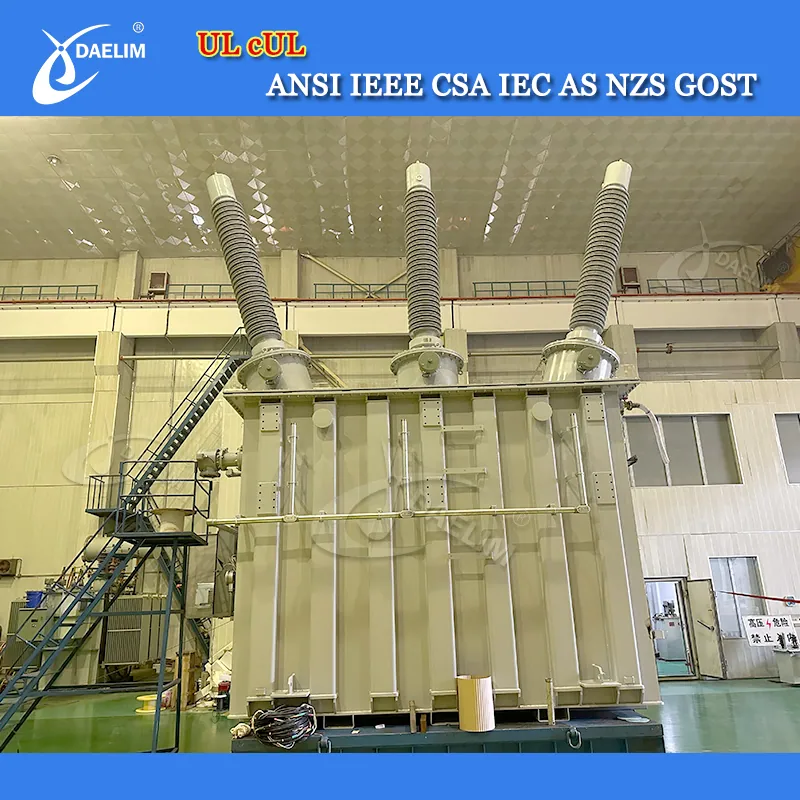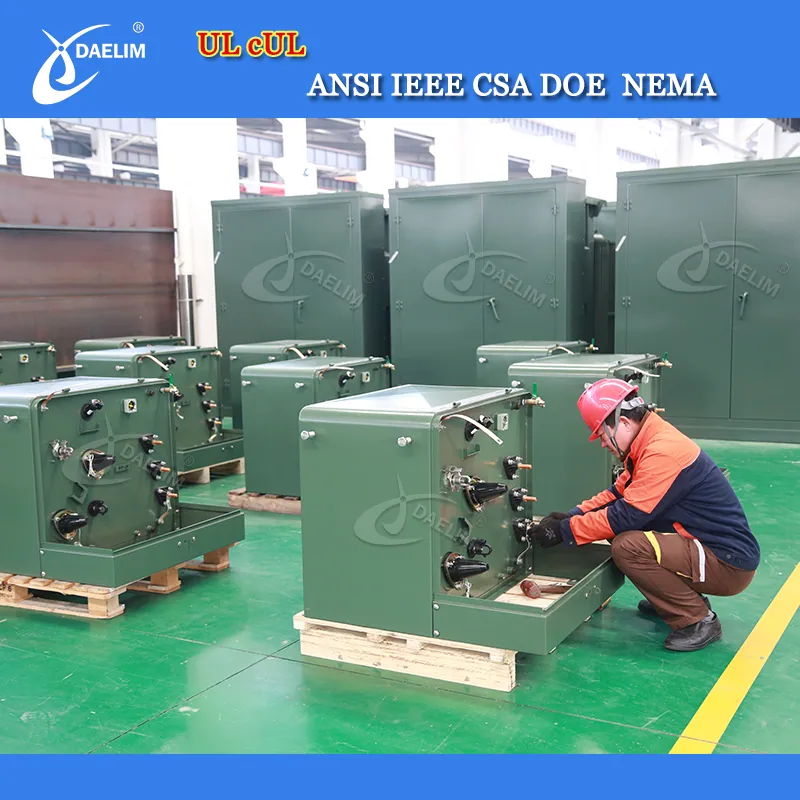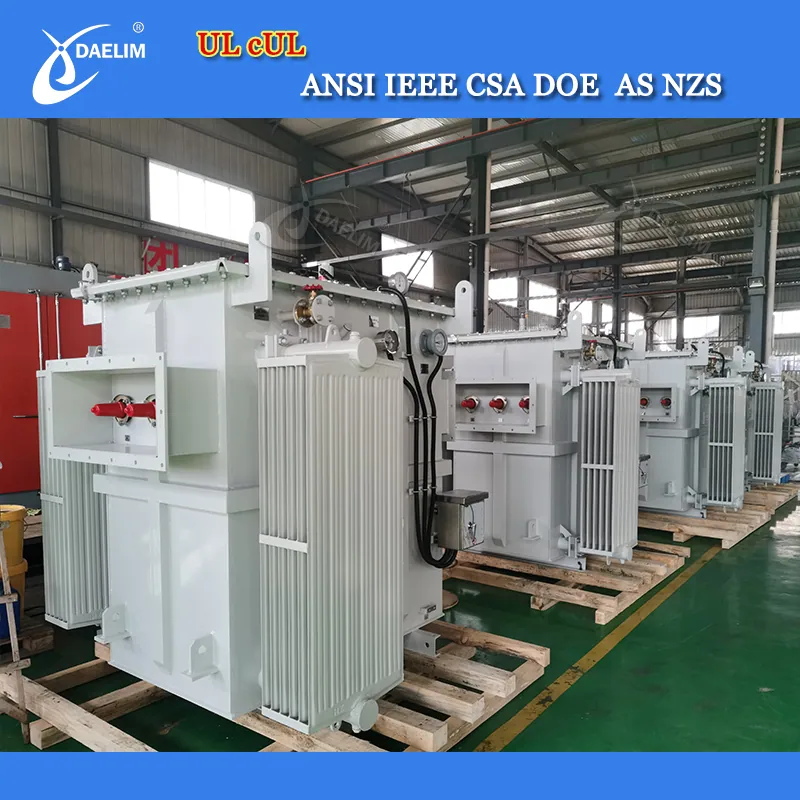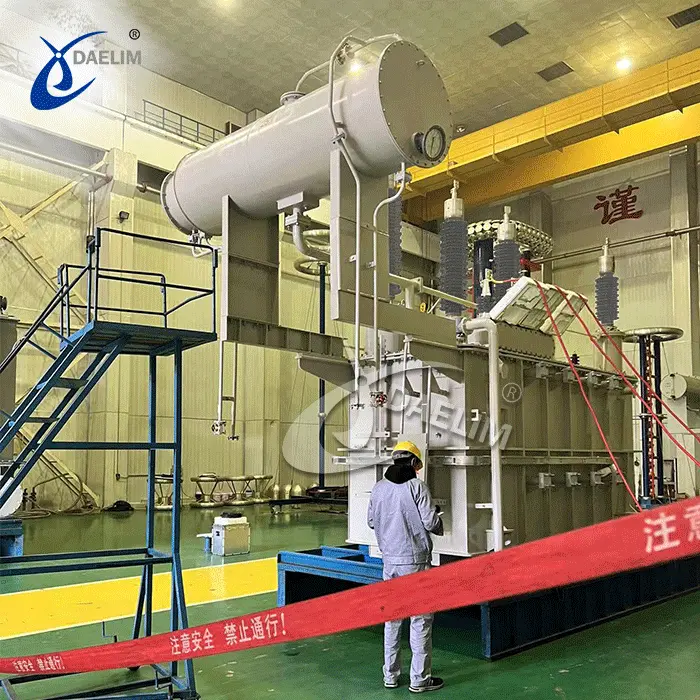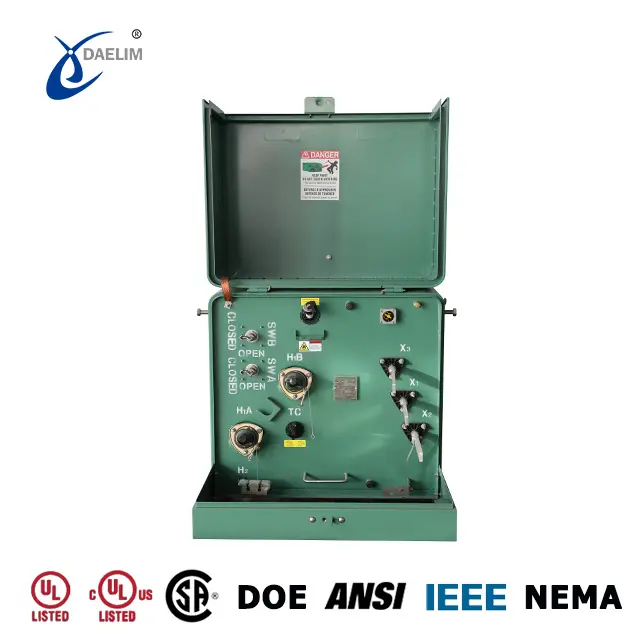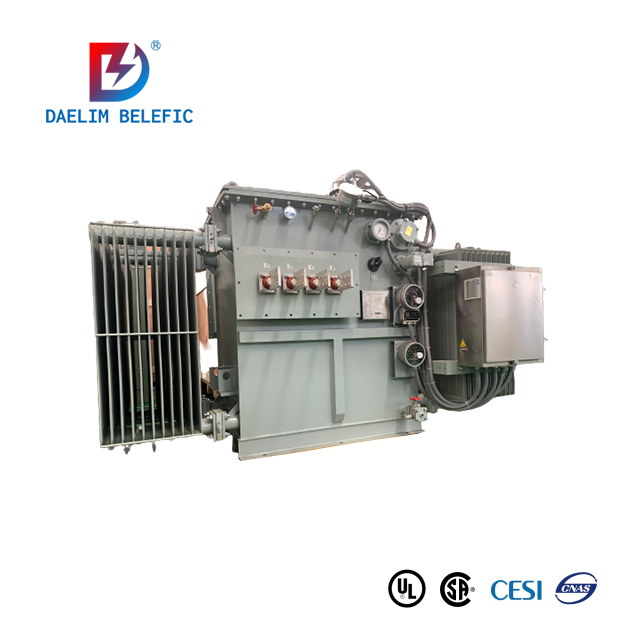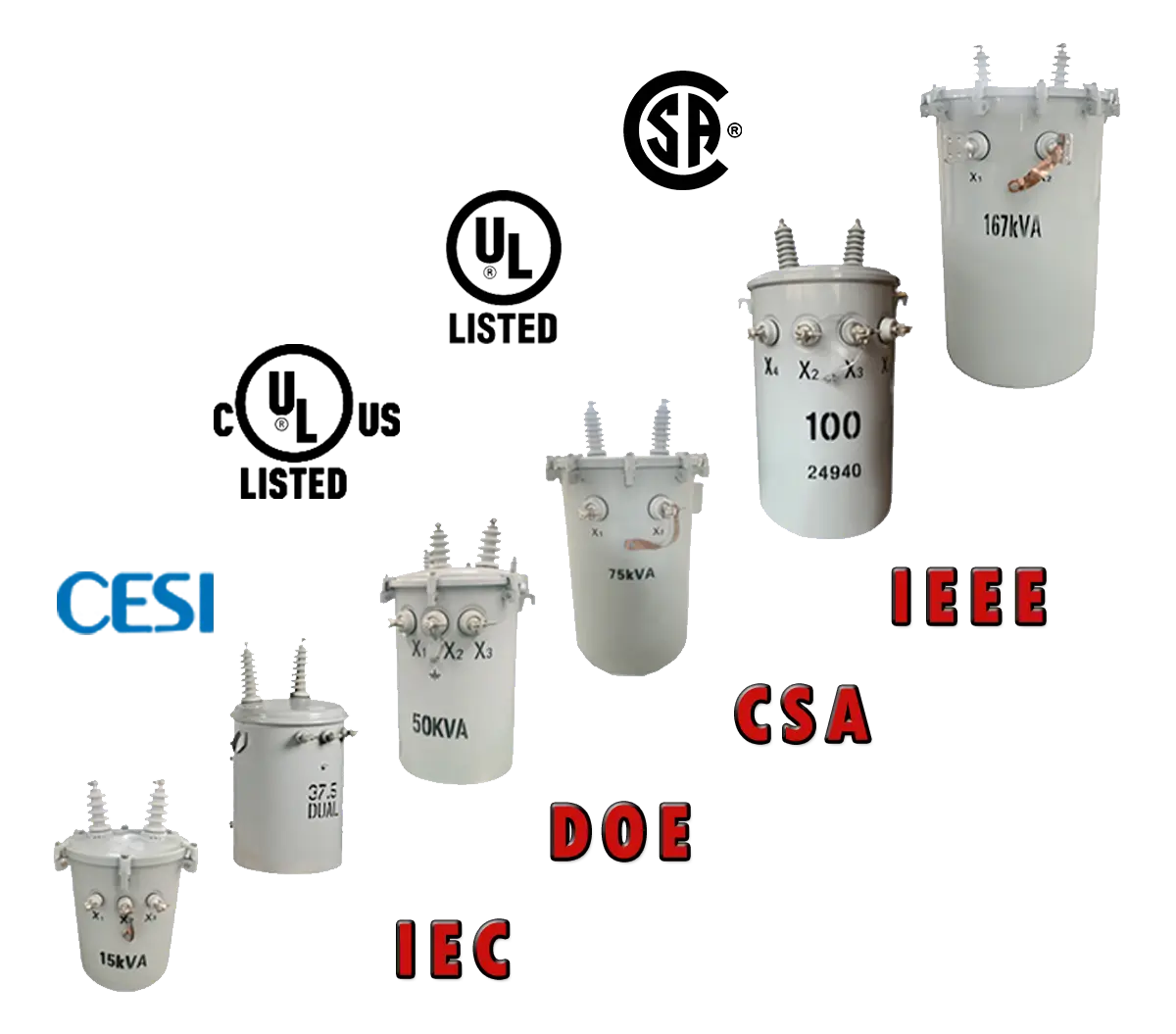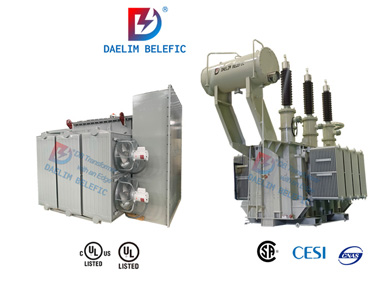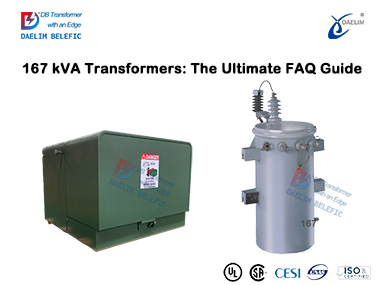High Voltage vs Medium Voltage Transformer

Medium Voltage and High Voltage Transformer is a common device in the power system. There are different types and classifications of transformers, one of the ways to classify it is according to the range or amount of voltage it can handle. Two of the most widely used voltage classifications are medium voltage transformers and high voltage transformers.
Daelim is a transformer manufacturer specializing in the production of Medium Voltage and High Voltage Transformers. Transformer products have a series of certificates: UL/CUL, CSA, CESI, CE, SGS, IEEE, etc. Medium Voltage and High Voltage Transformer technical standards exceed ANSI/IEEE, CSA, AS/AZS, GOST, IEC, etc. It has the advantage of fast delivery.
This range is standardized based on various electrical codes which is one of the basis for this comparison. In this article, we will learn more about them, their differences, and their applications.
Contact Daelim TransformerWhat is a medium voltage transformer?

A medium voltage transformer is an electrical device used for altering the voltage levels in the medium voltage range. In the United States, medium voltage typically refers to voltage levels between 1,000 and 69,000 volts. These transformers are crucial components in power distribution systems, as they step up or step down the voltage to facilitate efficient transmission and distribution of electricity. They are commonly employed in industrial, commercial, and utility applications to ensure the safe and reliable operation of electrical equipment.
Try for free: Electric Power Substation Transformers - 220KV-69KV-138KV
Medium Voltage Transformer Types
Medium voltage transformers are categorized into several types: pole-mounted transformers, pad-mounted transformers, small substation transformers, and dry-type transformers.
Pad-Mounted Transformers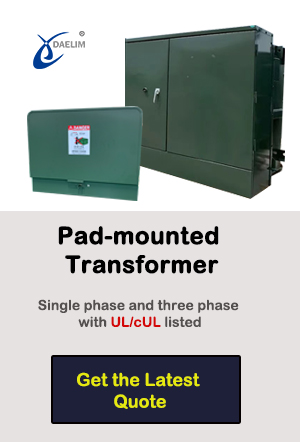
Widely utilized in North and South America, pad-mounted transformers are integral to underground electrical systems. They are available as both three-phase and single-phase models, designed with tamper-proof features that facilitate installation and maintenance.
This medium voltage transformer type usually comes with an enclosure in the form of metal cabinets that typically rest or are supported by a concrete pad.
This enclosure provides added security and safety even if a pad-mounted transformer is stationed in a fairly crowded area like an industrial park.
This type of transformer can be availed in a single-phase format if the voltage requirement is on the lower bracket and in a three-phase format if the voltage requirement is on the upper bracket.
Daelim transformer suppliers can produce three phase pad mounted transformers and single phase pad mounted transformers with UL/CUL. There are a lot of cases of pad mounted transformers in the United States and Canada, and after-sales installation services and maintenance teams in the United States and Canada. Help you solve all problems.
Daelim Belefic 3 Phase Pad Mounted Transformer
Pole-Mounted Transformers
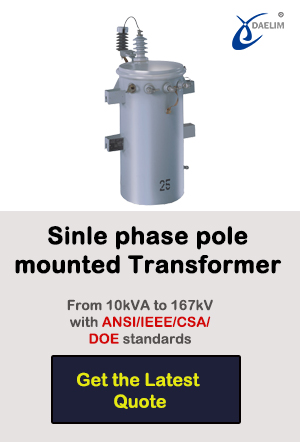
This transformer type could be the most common type seen in cylindrical containers hanging around every neighborhood's electrical pole.
They are very efficient and practical to use. They can also withstand all types of elements and are small in size which makes them ideal for various applications, especially in hard-to-reach areas.
Standard pole-mounted transformers are usually single phase but they can also be purchased in a three-phase format which offers an array of added value and advantages.
Daelim Pole Mounted Transformer has a series of certificates such as UL/CUL, SGS, CSA, IEEE, and CESI, which can help you develop the market. Similarly, local after-sales teams can solve all the after-sales problems of your customers.
Reading more: The Ultimate Guide to Pole Mounted Transformers
Small Substation Transformers
 Commonly employed in North America and Australia, small substation transformers can reach capacities of up to 25 MVA. These versatile transformers can be equipped with or without oil conservators, offering flexible high and low-voltage designs that adapt to various applications such as top or side mounting. Optional remote monitoring contacts enhance their functionality.
Commonly employed in North America and Australia, small substation transformers can reach capacities of up to 25 MVA. These versatile transformers can be equipped with or without oil conservators, offering flexible high and low-voltage designs that adapt to various applications such as top or side mounting. Optional remote monitoring contacts enhance their functionality.
This medium transformer type is more sophisticated. It serves as the core in every substation that is responsible for regulating the voltage produced from power generation.
It falls under the higher rating bracket and is normally rated based on the relationship between the input voltage and output voltages.
Substation transformers are comparably larger than the first two types. Its cooling system is also more advanced.
Usually, substations are oil immersed and have additional accessories such as fans and pumps for faster cooling action and heat dissipation.
Learn more: Substation Transformer Ultimate Guide, You Need To Know
Dry Type Transformer
Distinguishing itself from the previously mentioned transformer types, the dry-type transformer operates without internal insulating oil. It is constructed using a silicon steel sheet core and an epoxy resin-casted coil. Structurally, it can be categorized into solid insulation encapsulated winding and non-encapsulated winding designs. This type of transformer boasts attributes such as moisture resistance, explosion resistance, fire resistance, absence of pollution, and exceptional safety features.
Daelim Transformer is a professional ANSI, IEEE, and CSA standards transformer manufacturer with UL Listed. Whether your requirements encompass single-phase or three-phase solutions, oil-immersed or dry-type designs, overhead installations, or pad-mounted configurations, Daelim Transformer stands ready to cater to your needs. Feel free to connect with us to experience transformer solutions of unmatched quality and precision.
Where are medium voltage transformers used?
Utility companies, industrial facilities, commercial buildings, and even certain residential uses medium voltage transformers.
A medium voltage transformer provides an essential conduit between the power supply and end-use machinery, including motors, lighting systems, and HVAC systems.
As a matter of fact, medium voltage transformers come in a variety of designs, including dry and liquid-filled varieties.
- The core and windings of liquid-filled transformers are generally cooled and insulated using an insulating liquid, such as mineral oil or synthetic fluid.
- On the other hand, dry-type transformers use air or gas as the cooling and insulating medium, making them suited for settings with stringent fire safety regulations.
Medium voltage transformers are primarily used in power distribution systems and are also used for the following application:
- Voltage regulation at the residential level
- Data and server centers
- Civil infrastructure
- Commercial buildings
- Medium voltage industrial requirements
- Power stations
- Electric grids
- Switch gears
- Control systems
- Voltage optimization
Overall, the choice of a suitable medium voltage transformer is essential for the particular application and environment because each kind has advantages and limitations.
Learn more: Different Transformer Types and Their Applications
Who Are The Main Medium Voltage Transformer Manufacturers?
With multiple major companies offering top-notch goods and services, the medium voltage transformer market is extremely competitive.
ABB Ltd and Eaton Corporation are a few of the major players.
ABB Medium Voltage Transformer
ABB Ltd., a multinational company with Swiss and Swedish roots, is a significant player in the market for medium voltage transformers.
With a huge network of production facilities, sales offices, and service centers, ABB is one of the medium voltage transformer manufacturers.
They ensure that they deliver practical medium voltage transformer price lists and suitable medium voltage transformer sizes for their clients.
In fact, ABB invests $1.1 million in medium voltage sensors to meet the unprecedented demand.
They even made a $1.1 million investment in a modern facilities sensor production facility.
ABB's medium voltage transformer price list could vary between $22,500 to $500,000. Of course, this will all be depending on ABB's medium voltage transformer sizes and customization.
However, it's essential to understand that this figure may not accurately represent the cost for all ABB medium voltage transformers.
Eaton Medium Voltage Transformers
Eaton makes it to the 4th place when it comes to being one of the medium voltage transformer manufacturers.
Last 2021, Eaton made a sale of at least $19.6B not only for their medium voltage transformer but all of their other power transformers.
Just like with ABB, EATON medium voltage transformers can be highly customized to fit unique customer needs and application requirements.
They offer versatility in terms of voltage rating, capacity, and other characteristics to make sure that they meet the client's demand.
This is especially true when customizing medium voltage transformer sizes for different projects. As well as meeting the client's medium voltage transformer price list budget.
Eaton's medium voltage transformer price list can range from $50,000 to $1,000,000.
In addition, when you purchase more distinct medium voltage transformer sizes, the price can increase as the size or power rating increases.
How Do I Determine The Appropriate Medium Voltage Transformer Size For My Needs?
To determine the correct transformer size, use a medium voltage transformer calculator.
As you can see, the load's kVA determines the transformer's size. At the same time, to determine the proper transformer, find the source and destination voltages, frequency, and current.
1. Factors Affecting Size Selection
Determine the electrical load that the medium voltage transformer will deliver. Take into account the linked equipment or system's necessary voltage and current.
Multiply the load's voltage and current to determine the power rating needed for your application.
Consider the intended level of efficiency for the medium voltage transformer as it may affect future cost savings.
2. Medium Voltage Transformer Sizes
Medium voltage transformer sizes might vary depending on the manufacturer and specific model.
Several medium voltage transformer manufacturers frequently provide a wide variety to meet the needs of applications.
Medium voltage transformers are available in a variety of sizes, including:
- 15 kVA
- 25 kVA
- 45 kVA
- 50 kVA
- 75 kVA
- 150 kVA
- 225 kVA
- 250 kVA
- 300 kVA
- 500 kVA
- 750 kVA
- 1000 kVA
- 1500 kVA
- 2000 kVA
- 2500 kVA
- 3000 kVA
- 5000 kVA
You can also use a medium voltage transformer sizing chart as a reference tool for finding the proper transformer sizes based on various load data. Customers can quickly calculate the ideal medium voltage transformer sizes based on their specific load requirements by using the chart.
3. Using A Medium Voltage Transformer Calculator
Using a medium voltage transformer calculator, you can quickly and easily find the primary and secondary full-load currents of the transformer.
The label on the device specifies the voltage and current needed to power the load.
Then we multiply them, and to describe the result in kVA, we divide the result by 1000.
4. Professional Medium Transformer Supplier
You can consult a professional transformer supplier, and their transformer engineers can give you an accurate transformer size solution according to your application requirements.
Try for free: Ultimate Guide To Transformer Sizes and Ratings
How Can I Find A Reliable Medium Voltage Transformer Price List?
When comparing medium voltage transformer price lists, it's a good idea to ask for precise quotations.
Then go over the product specs, and take the reputation and track record of the manufacturers or distributors into account.
Factors Affecting Price
A medium voltage transformer price list depends on several factors, including the following:
- Power Rating
- Voltage Class
- Construction And Design Characteristics
- Efficiency
- Customization
- Raw Material Costs
- Market Conditions
It is essential to consider these factors and consult medium voltage transformer manufacturers to obtain accurate pricing information based on specific requirements.
Step 1. Obtain Price Lists From Medium Voltage Transformer Manufacturers
Identify trustworthy medium voltage transformer manufacturers.
Then try to find organizations that have been around for a while and have a good track record.
As mentioned earlier, ABB, Eaton, and Daelim are the top medium-voltage transformer manufacturers worldwide.
You can go to their websites, brochures, or price lists that can be downloaded.
Step 2. Provide Detailed Requirements
Provide the medium voltage transformer manufacturers the particular information about your requirements.
Include specifics like power rating, voltage class, preferred designs, customization requirements, and any other pertinent information.
ABB, EATON, and Daelim medium voltage transformers are more likely to provide accurate pricing information the more specific you are.
Step 3. Compare Medium Voltage Transformer Price List Among Different Manufacturers
Compare any extra features or choices that the medium voltage transformer manufacturers may offer.
These may contain advanced monitoring systems, safety equipment, noise-canceling features, or certain customizability possibilities.
Evaluate the value that these features bring in addition to the product and take into account how that affects the price.
For example, ABB provided a unique type of maintenance-free, environmentally impure, and fire-risk-free medium voltage transformer to the Vatican.
While Eaton introduced their PEAK medium voltage transformer, which is specially created for managing increasing loads and capacity.
How Can I Ensure That My Medium Voltage Transformer Operates Safely And Efficiently?
To maintain the safe and efficient operation of your medium voltage transformer, several procedures should be always followed.
These include best practices for installation, routine maintenance and inspections, and adherence to safety laws and regulations.
Installation Best Practices
Following best practices is essential for the safe and dependable operation of a medium voltage transformer upon installation.
These procedures involve creating a suitable site with enough room and clearance and making sure the foundation is sound and properly anchored.
Medium voltage transformer manufacturers also advise to ensure proper electrical connections with the right cables and connectors.
Next is to establish a strong grounding system, offering sufficient cooling and ventilation and putting in place safety precautions.
Routine Maintenance And Inspections
It is essential to entrust the installation, inspection, and maintenance of medium voltage transformer to qualified personnel.
This is due to the potential hazards associated with normal operating voltages.
The frequency of maintenance depends on the installation conditions. In clean and dry locations, an annual inspection is typically sufficient.
However, in environments with dust or chemical vapors, more frequent inspections at three or six-month intervals may be necessary.
Following these guidelines helps ensure the reliable and safe functioning of medium voltage transformer.
Safety Guidelines And Regulations
In order to do this, one must follow all applicable electrical codes and standards and hire qualified personnel for installation and maintenance.
In installing a medium voltage transformer, you should also provide appropriate personal protective equipment (PPE) and implement lockout/tagout procedures.
According to medium voltage transformer manufacturers, one must conduct routine inspections and maintenance, offer training and education, and maintain thorough documentation.
You may enjoy: 25 kVA Transformer, Get The Price Quickly
Is It Possible To Run Medium Voltage Transformers In Parallel?
Yes, medium voltage transformers may be potentially used in parallel to provide redundancy or support higher load needs.
However, synchronization and suitable control systems are necessary to ensure fair load sharing, voltage regulation, and protection coordination between the parallel transformers.
If the medium voltage transformer voltage ratings differ, there will be significant circulation currents in both the primary and secondary windings.
Medium voltage transformers are usually connected in the same order, according to their polarity, when used in a parallel combination.
Incorrect polarity connections will result in a dead short circuit in these transformers.
What Is The Expected Lifespan Of A Medium Voltage Transformer?
When utilized in accordance with ANSI / IEEE basic loading conditions, a transformer's lifespan is usually between 20 and 30 years.
Nevertheless, certain high-voltage models can last 50 or 60 years with careful maintenance.
Keep in mind that your medium voltage transformer needs to be examined every six months.
Look for flash point, sludge content, acidity, and dielectric strength as well as how resistant it is to transformer oil.
Remember that the longevity of a medium voltage transformer may be influenced by load profiles, maintenance practices, and operating circumstances.
What Causes A Medium Voltage Transformer To Fail?
A medium voltage transformer may exhibit several indicators that can point to potential problems.
Unusual rattling or buzzing sounds, high temperatures, obvious oil leaks, and strange aromas point to internal problems or insulation problems.
In addition, mechanical or electrical issues are generally indicated by decreased efficiency, vibrations, and strange visual phenomena.
Moreover, you should not disregard voltage or current fluctuations, as well as alerts from monitoring systems.
Lastly, the findings of a dirty oil show that medium voltage transformer
may include contaminants, moisture, or acidity.
Get it now: Transformers Solution For Data Center and Cryptocurrency Mining
What Is The Typical Maintenance Schedule For A Medium Voltage Transformer?
Circuit breakers for medium voltage transformers that range in voltage from 600 to 15,000 volts should be always serviced and inspected once a year, or after 2,000 operations, whichever comes first.
Visual inspections, electrical testing, and oil sampling are examples of routine maintenance activities that are frequently carried out annually or at predetermined intervals.
Referring to the manufacturer's instructions for the specific medium voltage transformer model is necessary.
Are There Any Environmental Considerations Associated With Medium Voltage Transformers?
Yes, medium voltage transformers frequently include insulating oil, which can malfunction, leak, or even catch fire at times, endangering the environment.
Whereas, traditional transformers have substantial shielding and concrete pools installed to help with this problem.
As you can see, medium voltage transformers may need to be appropriately disposed of or recycled when they are nearing the end of their useful lives.
This is especially true if they use liquid insulation or cooling methods.
Daelim Is Your Trusted Medium Voltage Transformer Manufacturer
We at Daelim are proud to be a well-respected medium voltage transformer manufacturers.
Our medium voltage transformer are technically designed to withstand difficult circumstances, give reliable performance, and supply constant power.
We offer a reliable medium voltage transformer price list while assisting you in achieving your sustainability objectives.
Our extensive network of partners and distributors ensures prompt delivery, technical assistance, and reliable after-sales support of different medium voltage transformer sizes.
Get in touch with us right now to find out how we can fulfill your unique needs and take your medium voltage transformer to new heights.
What is high voltage transformer?
As the name suggests, a high-voltage transformer is a variety of transformers that can handle high levels of voltage.
If we look up the American National Standard Institute, it says that this type of transformer can manage voltage levels from 115kV up to 1,100kV.
They play an important part in supplying power to special electrical instruments and pieces of equipment, as well as increasing efficiency in the power systems, upon distribution, and during transmission.
Since it deals with high voltage levels, a high-voltage transformer is technically developed to withstand the amount of heat generated during its operation and potential surges.
With that, high Voltage transformers are specially designed to have robust insulation and a highly efficient cooling system.
Read more: High Voltage Transformer Guide In 2022
High-voltage transformer types

There are three types of high-voltage transformers. These are the High Voltage transformer, the Extra High Voltage transformer, and the Ultra High Voltage transformer.
Each type can be classified according to the scope of its system voltage.
Falls under the nominal system voltage class that can handle 100 kV up to 230 kV
Extra High Voltage Transformers
This class can handle beyond 230 kV up to not more than 1000 kV
Ultra High Voltage Transformers
This class can manage as much as 1000 kV or more.
What are high voltage transformers used for?
High Voltage Transformers are mainly utilized in applications where they receive extremely high voltages and transform them into a particular voltage level that is safe for the needed application.
High Voltage Transformer application includes:
- Stepping down purposes
- Special equipment isolation
- Power distribution and transmission
- High voltage testing laboratories
- Hybrid vehicles
- Plasma generation equipment
- Wind turbines
- Solar power plants
- Transportation industries
- Medical field
- Manufacturing sites
Learn more: Basic Guide To High Voltage Power Transformers
Advantages and disadvantages of high voltage transformers
| ADVANTAGES | DISADVANTAGES |
| Can work over long distances | High upfront cost |
| Reduce power losses | Requires more robust insulation and protection |
| There's a lot of room for expansion | Complex design |
| Higher efficiency | Potential noise |
| Wide range | Higher risk in operation |
What is the difference between medium voltage and high voltage?
Apart from the difference in the voltage range here is the summary of the difference between medium voltage and high voltage.
| Medium Voltage | High Voltage |
| Can range from 1 kV up to not more than 50 kV | Can range from 69 kV up to 230 kV |
| Normally used for distribution. | Normally used for transmission |
| Parts are readily available | Parts could be specially made |
| Common design | Special design |
| Low risk of electric shock | High risk of electrocution |
Get it now: How Much You Know To Purchase The 12.5 MVA Transformer In 2022?
Advantages and disadvantages of medium voltage transformers
| ADVANTAGES | DISADVANTAGES |
| Easy to handle and maintain | Limited voltage range |
| Low cost and highly economical | Lower potential energy |
| Efficient | Might need to be upgraded |
| Versatile application | Application is specific |
Reading on: 11kV Transformer Guide 2022-Daelimtransformer
Which one is better, high voltage or medium voltage transformer?
When it comes to transformers, there's no one size fits all answer. The answer would definitely depend on what you need.
High voltage transformers and medium voltage transformers are uniquely created to serve different purposes that are both essential in the field of power generation and distribution.
As mentioned both have their own advantages and disadvantages but it would boil down to what is more practical for your application.
If your application is more on distribution where the voltage requirement is less than 100 kV, then a medium voltage transformer is best for you.
On the other hand, if your application is inclined towards power transmission where the voltage requirements can be as high as 230 kV, then a high-voltage transformer is ideal for you.
The Ultimate FAQs Guide 20 MVA Transformer Daelim
High Voltage and Medium Voltage Transformer for Sale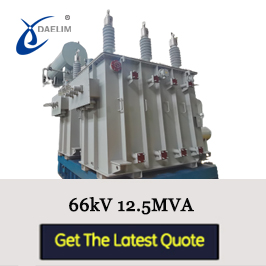
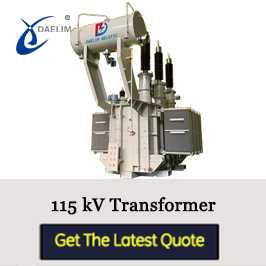
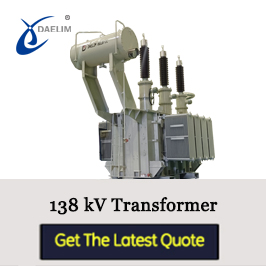
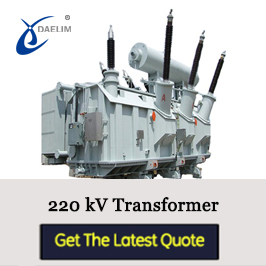
Daelim is a trusted transformer manufacturer in China that has the capability to produce both medium voltage transformers and high voltage transformers.
With its own high-tech manufacturing facility, every client is assured of getting the best price offer possible at an ultra-short delivery time.
The facility is armed with its in-house testing facility to ensure that every medium voltage transformer and high voltage transformer produced complies with the national standards.
Depending on clients' requests, Daelim transformers are all set to comply according to various national standards including ANSI/IEEE, CSA, AS/AZS, DOE, NEMA, IEC, GOST, and others.
Compliance is backed by product certifications such as UL/cUL, CSA, IEEE, CESI, CE, and other certificates applicable.
A good service would not be complete without good after-sales monitoring. Here at Daelim, you will never be left behind.
One of our strengths is taking care of our clients as soon as we receive the order and right after delivery. And, you can check the production and progress of your transformer at any time.
Daelim has various after-sales installations around the US willing to help you every step of the way.
The Ultimate FAQs Guide Daelim Transformer Efficiency
Daelim’s Range of Medium Voltage and High Voltage Transformer Products
Transformer Type and Specifications
66kV Transformer Specifications
| Rated Power | High Voltage | Low Voltage | Connection symbol | No-load loss(KW) | On-load loss(KW) |
| 6.3MVA | 63kV 66kV 69kV | 6.3kV 6.6kV 10.5kV 11kV 33kV | YNd11 YNyn0 others | 9.4 | 34 |
| 8MVA | 11.2 | 40.4 | |||
| 10MVA | 13.1 | 47.6 | |||
| 12.5MVA | 15.4 | 56.5 | |||
| 16MVA | 18.5 | 69.5 | |||
| 20MVA | 21.8 | 84.2 | |||
| 25MVA | 25.6 | 99.5 | |||
| 31.5MVA | 30.4 | 120 | |||
| 40MVA | 36.2 | 140.3 | |||
| 50MVA | 42.6 | 174.3 | |||
| 63MVA | 52 | 210 |
110 kV Transformer Specifications
| 110kv Three-phase duplex winding power transformer on load changer | |||||
| Rated Power | High Voltage | Low Voltage | No Load Loss | Load Loss | No Load current |
| 6.3MVA | 110kV 115kV | 6.3kV 6.6kV 10.5kV 11kV 33kV | 10 | 36 | 0.8 |
| 8MVA | 12 | 45 | 0.8 | ||
| 10MVA | 14.2 | 53 | 0.74 | ||
| 12.5MVA | 16.8 | 63 | 0.74 | ||
| 16MVA | 20.2 | 77 | 0.69 | ||
| 20MVA | 24 | 93 | 0.69 | ||
| 25MVA | 28.4 | 110 | 0.64 | ||
| 31.5MVA | 33.8 | 133 | 0.64 | ||
| 40MVA | 40.4 | 156 | 0.58 | ||
| 50MVA | 47.8 | 194 | 0.58 | ||
| 63MVA | 56.8 | 234 | 0.52 | ||
| 110 kV Three phase three winding power transformer on load changer | |||||
| Rating | HV(kV) | MV(kV) | LV(kV) | No Load Loss | Load Loss |
| 6.3MVA | 110kV 115kV | 35kV 37kV 38.5kV | 6.3kV 6.6kV 10.5kV 11kV 33kV | 12 | 47 |
| 8MVA | 14.4 | 56 | |||
| 10MVA | 17.1 | 66 | |||
| 12.5MVA | 20.2 | 78 | |||
| 16MVA | 24.2 | 95 | |||
| 20MVA | 28.6 | 112 | |||
| 25MVA | 33.8 | 133 | |||
| 31.5MVA | 40.2 | 157 | |||
| 40MVA | 48.2 | 189 | |||
| 50MVA | 56.9 | 225 | |||
| 63MVA | 67.7 | 270 | |||
138kV Transformer Specifications
| Main Technical Parameters for oil-immersed power transformer | |||||
| Rated Power (kva) | High Voltage (kv) | Low Voltage (kv) | Connection symbol | No-load loss(KW) | On-load loss(KW) |
| 6.3MVA | 132kV 138kV | 6.3kV 6.6kV 10.5kV 11kV 33kV 69kV | YNd11 YNyn0 others | 9.4 | 34 |
| 8MVA | 11.2 | 40.4 | |||
| 10MVA | 13.1 | 47.6 | |||
| 12.5MVA | 15.4 | 56.5 | |||
| 16MVA | 18.5 | 69.5 | |||
| 20MVA | 21.8 | 84.2 | |||
| 25MVA | 25.6 | 99.5 | |||
| 31.5MVA | 30.4 | 120 | |||
| 40MVA | 36.2 | 140.3 | |||
| 50MVA | 42.6 | 174.3 | |||
| 63MVA | 52 | 210 | |||
230kv Transformer Specifications
| Technical Data for 3-phase two winding on-load-tap-changing power transformer | ||||||||
| Rated | High Voltage | Low Voltage | No-load loss(KW) | On-load loss(KW) | ||||
| S9 | S10 | S11 | S9 | S10 | S11 | |||
| 31.5MVA | 220kV 230kV 242kV | 6.3kV 6.6kV 10.5kV 11kV 20kV 34.5kV 35kV 69kV | 38 | 34 | 30 | 135 | 128 | 128 |
| 40MVA | 45 | 41 | 36 | 157 | 149 | 149 | ||
| 50MVA | 54 | 49 | 43 | 189 | 180 | 180 | ||
| 63MVA | 63 | 57 | 50 | 220 | 209 | 209 | ||
| 90MVA | 80 | 72 | 64 | 288 | 274 | 274 | ||
| 120MVA | 99 | 89 | 79 | 346 | 329 | 329 | ||
| 150MVA | 116 | 104 | 93 | 405 | 385 | 385 | ||
| 180MVA | 135 | 122 | 108 | 468 | 445 | 445 | ||
22kv Transformer
| 10kV-35kV Distribution Transformer | |||||
| Rated Power | High Voltage | Low Voltage | No-load loss(W) | On-load loss(W) | No load current (%) |
| 400 kVA | 7.2kV 11kV 13.2kV 13.8kV 22kV 25kV 34.5kV 35kV | 400V 415V 480V 600V | 570 | 4300 | 0.45 |
| 500 kVA | 680 | 5410 | 0.45 | ||
| 630 kVA | 810 | 30800 | 0.4 | ||
| 800 kVA | 980 | 7500 | 0.4 | ||
| 1000 kVA | 1150 | 10300 | 0.35 | ||
| 1250 kVA | 1360 | 12000 | 0.3 | ||
| 1600 kVA | 1640 | 145000 | 0.6 | ||
| 2000 kVA | 1950 | 19140 | 0.6 | ||
| 2500 kVA | 2340 | 22220 | 0.5 | ||
33kv to 415v Transformer
| Rated Power | High Voltage | Low Voltage | No Load Loss (W) | On Load Loss (W) |
| 800kVA | 35kV 38.5kV 44kV 46kV | 6.3kV 6.6kV 10kV 10.5kV 11kV 12.47kV 13.8kV | 980 | 9350 |
| 1000kVA | 1160 | 11500 | ||
| 1250kVA | 1380 | 13900 | ||
| 1600kVA | 1660 | 1600 | ||
| 2000kVA | 2030 | 19300 | ||
| 2500kVA | 2450 | 19600 | ||
| 3150kVA | 3010 | 23000 | ||
| 4000kVA | 3610 | 27200 | ||
| 5000kVA | 4270 | 31200 | ||
| 6300kVA | 5110 | 34900 | ||
| 8000kVA | 7000 | 38300 | ||
| 10000kVA | 8260 | 45100 | ||
| 12500kVA | 10800 | 53600 | ||
| 16000kVA | 11900 | 65500 | ||
| 20000kVA | 14100 | 79100 | ||
| 25000kVA | 16730 | 93500 |
You may enjoy: Do you want to learn more a 34.5 kv transformer?
Related Products
Related Article
Power Transformer Manufacturers Around the World
In this article, we will tackle the top power transformer manufacturers around the world including snippets of the most powerful transformer and a short guide on how to choose a power transformer manufacturer.
The Ultimate FAQs Guid To Oil Type Transformer
An oil-type transformer is a kind of transformer that uses oil as a cooling and insulating medium. The core and coils of an oil-type transformer are immersed in oil, which helps to cool the transformer and provides insulation.
Exploring Everything About 2000 kVA Transformer
2000 kVA transformers are perfect for public utilities, cryptocurrency mining, data centers, solar farms, power substations, and other industrial applications.
The Ultimate FAQ Guide To 167 kVA Transformers
There are many types of 167kva transformers, such as single-phase pole transformers, single-phase pad-mounted transformers, dry transformers, and so on. This article will talk about the 167kva transformer in detail.
Solar Transformer, Get The Best Price
Solar energy is the most abundant energy source on earth, and contemporary solar energy can be used to produce other renewable energy sources. We can convert solar energy into electricity. At present, there are two main conversion forms in the world, one is solar photovoltaic power stations, and the other is solar thermal power stations. Whether it is photovoltaic power generation or solar thermal power generation, solar transformers are used.
Power Transformer-The Ultimate FAQs Guide
Power transformers are one of the most important equipment in the electrical power system. If you have any questions regarding power transformers, you'll find all of the answers you're looking for here.

